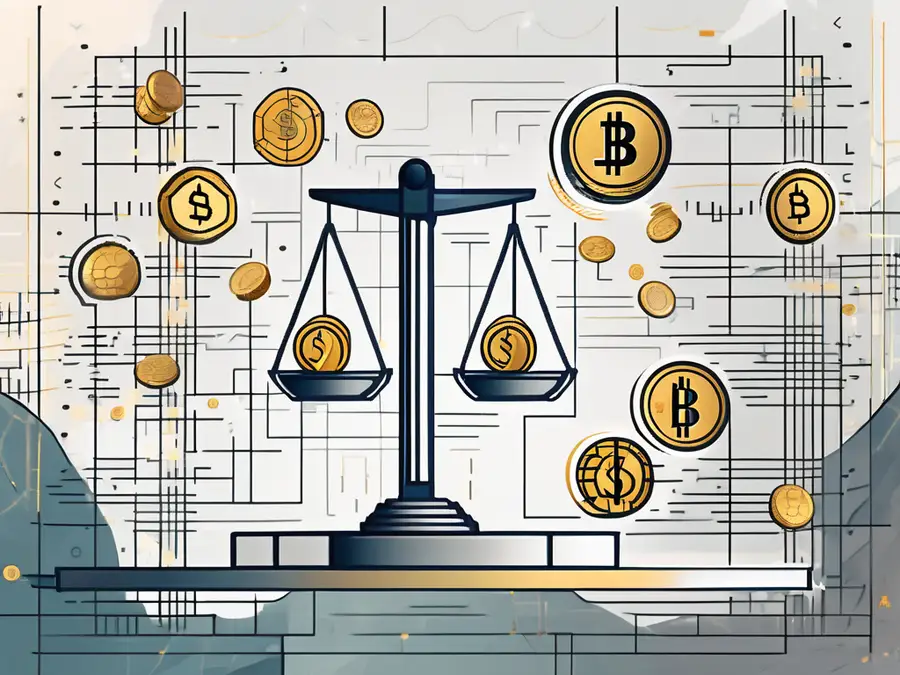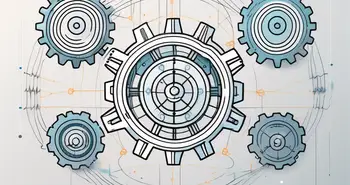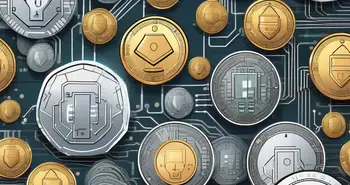An Introduction to the Algorithmic Stablecoins

As an expert in the field of cryptocurrency, I am thrilled to present to you the ultimate guide to algorithmic stablecoins. In this comprehensive article, we will dive deep into the world of algorithmic stablecoins, exploring their basics, inner workings, different types, and the pros and cons they bring to the table. Join me on this exciting journey as we unravel the mysteries behind algorithmic stablecoins and gain a deeper understanding of their significance in the crypto market.
Understanding the Basics of Algorithmic Stablecoins
Before delving into the intricacies of algorithmic stablecoins, let's start by understanding what they truly are. Algorithmic stablecoins are a type of cryptocurrency designed to maintain a stable value, often pegged to a traditional fiat currency like the US Dollar. Unlike traditional cryptocurrencies such as Bitcoin that experience volatile price fluctuations, algorithmic stablecoins aim to provide a more reliable and stable option in the ever-changing world of digital assets.
Algorithmic stablecoins have gained significant attention in recent years due to their potential to bridge the gap between the decentralized nature of cryptocurrencies and the stability of fiat currencies. By leveraging smart contracts and innovative mechanisms, algorithmic stablecoins aim to create a reliable form of digital currency that can be used for everyday transactions.
What are Algorithmic Stablecoins?
Algorithmic stablecoins are digital currencies that employ complex algorithms to maintain their stability. These algorithms adjust the coin's supply and demand dynamically, ensuring that the stablecoin's value remains close to the pegged asset, typically a fiat currency. Through this process, algorithmic stablecoins aim to achieve price stability, making them suitable for various use cases such as e-commerce, remittances, and store of value.
The Importance of Stablecoins in the Crypto Market
Stablecoins play a crucial role in the crypto market by addressing one of the primary challenges faced by traditional cryptocurrencies: volatility. The ability to provide a stable value makes stablecoins an attractive option for individuals and businesses looking for a reliable medium of exchange within the blockchain ecosystem. Moreover, stablecoins offer a gateway for individuals who want to venture into the world of cryptocurrencies but are hesitant due to the inherent price volatility of other digital assets.
How do Algorithmic Stablecoins Maintain Stability?
An algorithmic stablecoin maintains stability by implementing a combination of mechanisms. One such mechanism is through the use of smart contracts. Smart contracts act as self-executing digital agreements that automatically adjust the stablecoin's supply in response to changes in demand. When there is a high demand for the stablecoin, the smart contract can increase the supply to match the demand and maintain the stable value. Conversely, if the demand decreases, the smart contract can decrease the supply to keep the stablecoin's value intact.
In addition to smart contracts, algorithmic stablecoins often employ collateralization. Collateralization involves locking up a certain amount of another cryptocurrency or asset as collateral, which backs the value of the stablecoin. This collateral acts as a reserve, providing stability by ensuring that the stablecoin can always be redeemed for its underlying assets.
Another mechanism utilized by algorithmic stablecoins is seigniorage shares. Seigniorage shares enable the stablecoin system to mint new coins when there is a high demand for the stablecoin, increasing the stablecoin's supply. Conversely, when the demand decreases, the system can buy back the coins, reducing the supply and maintaining stability.
The Inner Workings of Algorithmic Stablecoins
Now that we have covered the basics of algorithmic stablecoins, let's take a closer look at the inner workings of these fascinating digital assets.
The Role of Smart Contracts
Smart contracts are at the heart of algorithmic stablecoins, playing a vital role in maintaining price stability. By automatically adjusting the supply based on demand, smart contracts enable algorithmic stablecoins to maintain their pegged value. These contracts execute predefined rules and conditions, ensuring that the stablecoin system operates according to its designed algorithm.
The Mechanism of Collateralization
Collateralization serves as a crucial element in stabilizing algorithmic stablecoins. By locking up collateral, such as cryptocurrencies or other assets, the stablecoin system ensures that each stablecoin in circulation is backed by a tangible and valuable reserve. This collateral acts as a safety net, reassuring users that the stablecoin has value and can be redeemed for its underlying assets.
The Process of Seigniorage Shares
Seigniorage shares are another mechanism utilized by algorithmic stablecoins to maintain stability. In this system, holders of seigniorage shares can claim a portion of newly minted stablecoins as a reward for their participation in the stablecoin ecosystem. This mechanism helps to regulate the supply of stablecoins, ensuring that the system can respond to changes in demand and maintain a stable value.
Different Types of Algorithmic Stablecoins
Algorithmic stablecoins come in various forms, each with its unique characteristics and mechanisms. Let's explore the different types of algorithmic stablecoins.
Seigniorage-Style Stablecoins
Seigniorage-style stablecoins, also known as algorithmic stablecoins, operate by adjusting the money supply in response to changes in demand. They use smart contracts and seigniorage shares to ensure stability. These stablecoins do not rely on collateralization and are purely algorithmic in nature.
Crypto-Collateralized Stablecoins
Crypto-collateralized stablecoins are backed by a collateral reserve consisting of other cryptocurrencies. The value of these stablecoins is maintained by ensuring that the total value of the collateral exceeds the value of the stablecoins in circulation. Examples of crypto-collateralized stablecoins include MakerDAO's DAI and Synthetix's sUSD.
Fiat-Collateralized Stablecoins
Fiat-collateralized stablecoins are backed by reserves of traditional fiat currencies, such as the US Dollar or Euro. These stablecoins are pegged to the value of their respective fiat currencies and aim to maintain a 1:1 ratio. Tether (USDT) and USD Coin (USDC) are prominent examples of fiat-collateralized stablecoins.
Pros and Cons of Algorithmic Stablecoins
Algorithmic stablecoins come with their own set of advantages and potential risks. Let's examine both sides of the coin.
Advantages of Algorithmic Stablecoins
One of the significant advantages of algorithmic stablecoins is that they offer stability in an otherwise volatile crypto market. They provide users with a reliable medium of exchange without the constant price fluctuations typically associated with traditional cryptocurrencies. Algorithmic stablecoins also enable individuals to hold and transact in digital assets while minimizing the risk of losing value due to wild price swings.
Furthermore, algorithmic stablecoins offer potential avenues for decentralized financial applications (DeFi) and financial inclusion. By providing a stable currency, algorithmic stablecoins can facilitate lending, borrowing, and other financial activities without the need for traditional banking intermediaries. This opens up opportunities for individuals who may not have access to traditional banking services.
Potential Risks and Drawbacks
While algorithmic stablecoins have the potential to revolutionize the world of digital currencies, they are not without their risks and drawbacks. One of the primary concerns is the stability of the stablecoin's peg. Since algorithmic stablecoins rely on various mechanisms and algorithms to maintain stability, there is always a risk of the peg breaking and the stablecoin's value deviating from its intended value.
Moreover, algorithmic stablecoins can be vulnerable to market manipulation and external factors that may impact their stability. The effectiveness of the mechanisms used by algorithmic stablecoins in maintaining stability relies heavily on the accuracy of the algorithms and the external factors affecting the stablecoin's market.
Conclusion
Algorithmic stablecoins have emerged as a fascinating solution to the volatility experienced by traditional cryptocurrencies. They provide stability in a fast-paced crypto market while still offering the benefits of decentralization. By leveraging smart contracts, collateralization, and seigniorage shares, algorithmic stablecoins aim to deliver a reliable and trustworthy form of digital currency.
As an expert in the field of cryptocurrencies, I encourage you to explore the world of algorithmic stablecoins further. These innovative digital assets hold great potential for revolutionizing the way we transact and store value in the digital age.
FAQ
What are algorithmic stablecoins?
Algorithmic stablecoins are digital currencies that leverage algorithms and mechanisms to maintain a stable value, often pegged to a traditional fiat currency. They aim to provide a reliable and stable option in the volatile world of cryptocurrencies, bridging the gap between decentralization and stability.
How do algorithmic stablecoins maintain stability?
Algorithmic stablecoins maintain stability through various mechanisms such as smart contracts, collateralization, and seigniorage shares. Smart contracts automatically adjust the stablecoin's supply based on demand, while collateralization ensures that each stablecoin is backed by tangible assets. Seigniorage shares regulate the supply of stablecoins by rewarding participants with newly minted coins.
What are the different types of algorithmic stablecoins?
There are three main types of algorithmic stablecoins: seigniorage-style stablecoins, crypto-collateralized stablecoins, and fiat-collateralized stablecoins. Seigniorage-style stablecoins use algorithms and smart contracts for stability, crypto-collateralized stablecoins are backed by collateral in other cryptocurrencies, and fiat-collateralized stablecoins are pegged to traditional fiat currencies.
What are the advantages of algorithmic stablecoins?
Algorithmic stablecoins offer stability in the crypto market, making them suitable for everyday transactions and store of value. They provide individuals and businesses with a reliable medium of exchange, minimizing the impact of price swings. Algorithmic stablecoins also have the potential to drive decentralized financial applications and promote financial inclusion.
What are the risks and drawbacks of algorithmic stablecoins?
The stability of algorithmic stablecoins is a primary concern as they rely on complex mechanisms and algorithms. There is a risk of the stablecoin's peg breaking, leading to a deviation from the intended value. Algorithmic stablecoins are also susceptible to market manipulation and external factors that may impact their stability.
Remember, it's essential to stay informed and do your own research before engaging with algorithmic stablecoins or any other crypto asset. The crypto market is dynamic, and risks are inherent. By staying knowledgeable and exercising caution, you can make informed decisions and navigate this exciting digital frontier.
As you consider the potential and intricacies of algorithmic stablecoins, why not take your trading experience to the next level with Morpher? Morpher.com is not just a trading platform; it's a revolution in the investment world, offering zero fees, infinite liquidity, and the ability to trade a vast array of assets, from cryptocurrencies to the most unconventional markets. With the added benefits of fractional investing, short selling without interest fees, and up to 10x leverage, Morpher empowers you to trade on your terms. Plus, the safety of a non-custodial Morpher Wallet puts you in full control of your funds. Ready to transform your trading journey? Sign Up and Get Your Free Sign Up Bonus today and join the future of investing with Morpher.

Disclaimer: All investments involve risk, and the past performance of a security, industry, sector, market, financial product, trading strategy, or individual’s trading does not guarantee future results or returns. Investors are fully responsible for any investment decisions they make. Such decisions should be based solely on an evaluation of their financial circumstances, investment objectives, risk tolerance, and liquidity needs. This post does not constitute investment advice.

Painless trading for everyone
Hundreds of markets all in one place - Apple, Bitcoin, Gold, Watches, NFTs, Sneakers and so much more.

Painless trading for everyone
Hundreds of markets all in one place - Apple, Bitcoin, Gold, Watches, NFTs, Sneakers and so much more.









